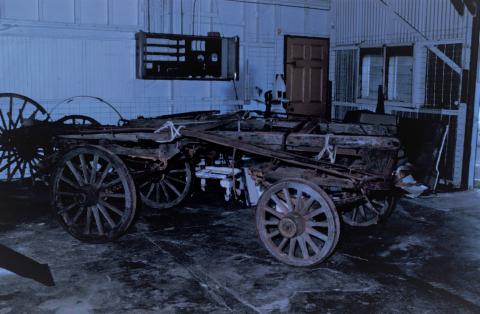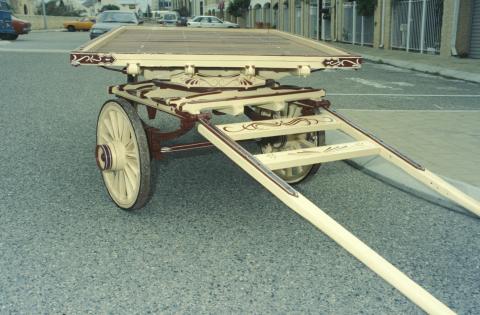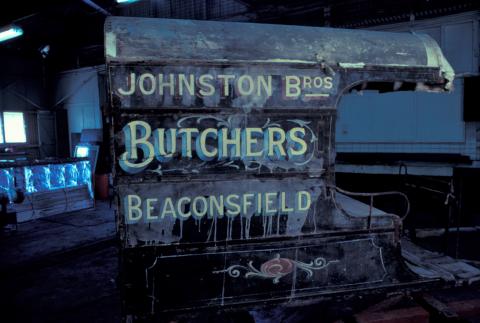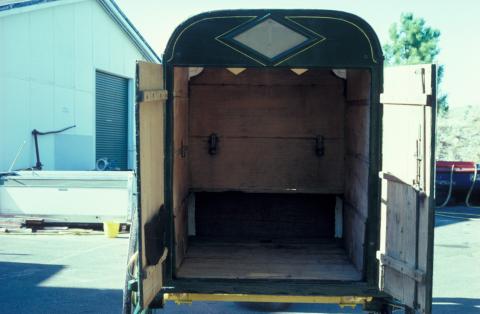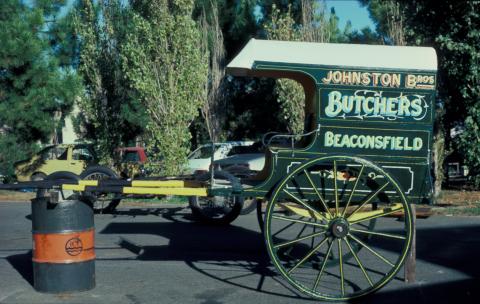Horse-drawn Vehicles
S. R. Garcia and D. Gilroy
Introduction
Horse-drawn vehicles are synonymous with Australia's history. From the Cobb & Co Coach and the ‘Sydney’ sulky to the bullock dray, horse-drawn vehicles have contributed significantly to Australia’s advancement. In the past few years hundreds of these wonderful vehicles have disappeared. Even today there are many vehicles just left to disintegrate in paddocks. With a few simple precautions, these can be saved from further deterioration.
Deterioration and Examination
The main materials used in the construction of horse-drawn vehicles are wood (one type or a mixture of woods), steel, paint and leather. All of these materials deteriorate when exposed to the elements. The normal modes and extent of deterioration of these material types is described elsewhere (see the chapters Wood, Metals and Leather).
If a vehicle is exposed outside the sun, rain and insects will soon damage spokes, felloes (wheel rims) and joints, eventually immobilising the vehicle.
Carefully examine and record the condition of a vehicle before attempting any work on it. Documentation should include:
- sketches and photographs of the vehicle and its components;
- notes on the condition of components;
- information regarding the original colours used on the vehicle. Scraping back to the original coats is usually necessary. Take paint samples if possible;
- details of any lettering, numbering or patterns present on the vehicle. Make a stencil of these; and
- any other details that may be of benefit in the conservation and restoration process.
Preventive Conservation
Conservation work may not always proceed immediately. If this is the case, move the vehicle under a shelter with the wheels and shafts supported and raised from the ground. These simple steps will prolong the vehicle’s life indefinitely. Stopping exposure to sunlight and periodic bouts of wetting and drying will minimise rot in the wood and rusting in metal components.
Make a simple stand to support the shafts and steel stands to support the axles. The latter stands are designed to raise the wheels about 6 – 12 mm above the ground.
A cover for the vehicle will help to prolong its life by protecting it from dust and the problems associated with the build-up of dirt.
Monitor the condition of the vehicle regularly. For instance, take photographs every 12 months and compare them. Take close-ups of susceptible areas.
Treatments
Conservation or Restoration
Conservation of a vehicle usually involves taking steps that will prevent any further deterioration in its condition. Restoration involves both conservation and additional work designed to restore the vehicle to something approaching its original condition.
As the current condition of a vehicle is a true reflection of its history, display in a ‘conserved only’ state is often desirable. Do not look upon complete restoration as a first option.
Wood Consolidation
If the vehicle has been exposed to the elements the wood is usually in a very poor condition. Leaving the vehicle standing on its wheels usually results in split and cracked spokes and felloes.
Unless the wood is badly deteriorated or load-bearing, use as much of the original wood as possible in any restoration. Retain all old wood, no matter how deteriorated and use as templates for the manufacture of replacement pieces. Keep these pieces in storage when not in use.
It may be necessary to split badly cracked pieces that are still robust enough to use before consolidating them. The wood can then be treated as follows:
- clean out all of the dirt and rotten wood;
- glue the sections with an appropriate wood glue and sawdust mixture and clamp them together. Do not use water-soluble glues if the vehicle is to be displayed outside;
- fill all cracks with a glue and sawdust mixture;
- sand it back to shape when the glue is dry; and
- paint the timber using a primer, an undercoat and a top coat. The top coat should match the original colour sample.
The last three steps outlined above can be used for all pieces of wood from the vehicle.
Wheel Repair
Wheels are often in a very sorry state, especially if termites have made them their home. Rebuilding wheels is a specialist craft. Seek expert guidance before disassembling and rebuilding them.
Another common problem is a build-up of rust between the inside of the tyre and the outside of the felloe. This type of problem may necessitate the removal of the tyre for treatment. If the tyre has to be removed, work upon the felloes and spokes becomes much easier. Consult a wheelwright if work of this type is necessary.
Chemical de-rusting of the tyre can be accomplished as described elsewhere (see the chapter Metals).
If the work required is of a minor nature, then splitting the felloe, cleaning as mentioned above and regluing may be all that is needed.
The case studies below demonstrate different treatments that can be applied to horse-drawn vehicles, with the particular treatments being determined by their respective conditions.
Wagon (New Norcia, Western Australia)
New Norcia is a farming community founded by Benedictine monks in the mid-19th century. Like all farming communities there was an abundance of horse-drawn vehicles, ranging from sulkies and buggies to general farm wagons. With the advent of the motor car and truck, horse-drawn vehicles fell into disuse and disrepair. They were left to rot in paddocks, lost in bushfires or broken up. Their numbers diminished alarmingly.
This was the case in New Norcia when the local historian realised that of all their horse-drawn vehicles, only one example of a four-wheeled general purpose cart remained.
Condition of the Vehicle
This vehicle had been on ‘display’ at the entrance to the town for many years and was in an advanced state of deterioration. The vehicle had been standing unsupported on its wheels, which had collapsed under the weight, was infested with black and white ants, had been modified and had dry and wet rot (Figure 3 a).
Initially it was felt that the vehicle was beyond redemption. As it was especially significant to the New Norcia community however, being the last of its kind and having been manufactured locally, it was decided to restore the vehicle.
Figure 3: (a) New Norcia wagon showing its pre-restoration condition.
(b) The wagon after restoration.
Research
Research is a critical factor in any restoration project. Relevant information to be considered included:
- photographs;
- plans;
- paint samples;
- traces of pin-striping or signage;
- wood identification; and
- condition of the object itself.
Paint samples were taken for colour matching and tracings were made of pin-striping and signage so that patterns could be reproduced accurately. This information was needed to ensure that when restored, the object would reflect its original state.
Photographs were taken before, during and at the completion of the project. Combined with written records of treatments, repairs and details of replacements of sections and parts, photographs form an essential part of the object’s more recent history.
Treatment Regime
Once the research had been completed the following work program was carried out (Figure 3 b):
- as much of the original timber as possible was used;
- timbers that were to be replaced were used as templates and then placed in storage;
- repairs were made to timber using sawdust and epoxy resin;
- timber was reshaped, primed and undercoated;
- all steelwork was removed and treated. Note that care was taken when treating the springs;
- steelwork was coated with a solution of fish oil and white spirit to protect the steel components and give a lustrous steel-grey finish. This was painted as required;
- the vehicle was top-coated with pin-striping and signage added as per the original; and
- stands were manufactured to fit under the axles to take the weight from the wheels.
Butcher's Cart (Fremantle, Western Australia)
A two-wheeled butcher’s cart was originally used to deliver meats in the Fremantle area.
Condition of the Vehicle
The exterior of the vehicle was ravaged by the elements with wood rot, deteriorating and flaking paint and rotting leather and waterproofing (Figure 4 a). As the interior of the vehicle held the meat, it was kept scrupulously clean and well maintained during the cart’s working life. As a result no treatment was needed for this part of the vehicle (Figure 4 b).
Research
All possible documentary and physical evidence was collected regarding the original appearance of the vehicle. In addition to the usual research and paint sampling, fabric samples were taken for identification. The sign writing was photographed, noting the colouring, type of shadowing and italics used.
Treatment Regime
The wood and steelwork were restored as described for the New Norcia vehicle. The cart was then painted to match its original colours (Figure 4 c).
Figure 4: Butcher’s Cart.
(a) Before treatment with the wheels and shafts missing.
(b) The worn interior of the cart was left in original condition.
(c) After restoration with replacement wheels and shafts.
Farm Wagon (Brookton, WA)
The four-wheeled farm wagon was built in 1903 in the Brookton area. The vehicle was housed in various sheds throughout its life and except for minor repairs carried out during its life, remains a good original example of a horse-drawn vehicle of the period.
Condition
Grease had solidified over the paint on the wheels and the wagon was covered with sand and dust. As sand and dust attract moisture, which begins the corrosion and rotting cycles, these needed to be removed.
Treatment Regime
- dust and sand were removed by careful brushing and dusting;
- minor repairs were made to cracking woodwork using an epoxy glue and sawdust mixture;
- solidified grease over the paint on the wheels was removed by careful brushing with soft brushes; and
- some minor surface rusting on the steelwork was treated.
Summary
The vehicles described above are now housed under cover, supported on stands which take the weight from the wheels. Regular monitoring and cleaning ensures there will be little need for further repairs for many years.
An important factor in the preservation of any object is the environment in which it is stored or displayed. Keep vehicles and machinery clean, dry and under cover. If objects cannot be stored indoors then this cover should be on two or three sides to prevent driving wind and rain from coming into contact with the objects.

